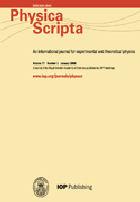|
Literature / Source Database:
Physica Scripta
Description
An international journal for experimental and theoretical physics
| Title (short) |
Phys. Scr. |
| Languages |
English |
| First year |
1970 |
| Impact factor |
1.194 |
|
|

|
Status
active
Indexing
ISI (SciSearch®, ISI Alerting Services, Materials Science Citation Index®); Scopus; Inspec; Chemical Abstracts Service; Compendex; GeoRef; MathSciNet;
INIS (International Nuclear Information System); NASA Astrophysics Data System; SPIRES; VINITI Abstracts Journal (Referativnyi Zhurnal); Zentralblatt MATH
Predecessor
Subject

Source type
Journal
ISBN ISSN
0031-8949
E ISSN
1402-4896
First volume
1
Last volume
77+
Homepage
| Resources |
|
Availability |
|
|
|
|
|
| Text PDF |
 |
free access |
 |
| Text Html |
 |
for subscriber |
 |
| References |
 |
not available |
 |
| Abstracts |
 |
|
|
| TOC |
 |
|
|
|
|
|
|

Description
Physica Scripta is an international journal for experimental and theoretical physics comprising strong components of atomic, molecular and optical physics, plasma physics, condensed matter physics and mathematical physics. The journal publishes comments in five different sections and maintains a program of topical issues alongside the regular 12 issues. Research papers. Reports of original research work; not normally more than 8500 words (14 journal pages). Comments. Reviews of the current thinking of leading researchers on outstanding problems. Comments may include discussion of open questions, questions that recent work has apparently closed, important new applications, new theoretical and experimental approaches, and predictions of future developments. They are intended to bridge gaps in readers' knowledge and provide insight into problems, methods and results in different areas of physics. Comments may address controversial topics on which different experts have different views, provided the author fairly represents all sides of the controversy. A good Comment will provide an authoritative contribution by an acknowledged expert, and also readily engage non-experts and graduate students. The writing style may be similar to a brief review, an introductory colloquium, or a personal “column” guiding readers to the latest progress and problems in the topic. Authors are encouraged to write articles of 2500 – 6000 words in length, although there is no strict page limit.
|